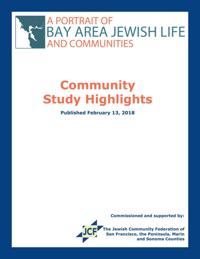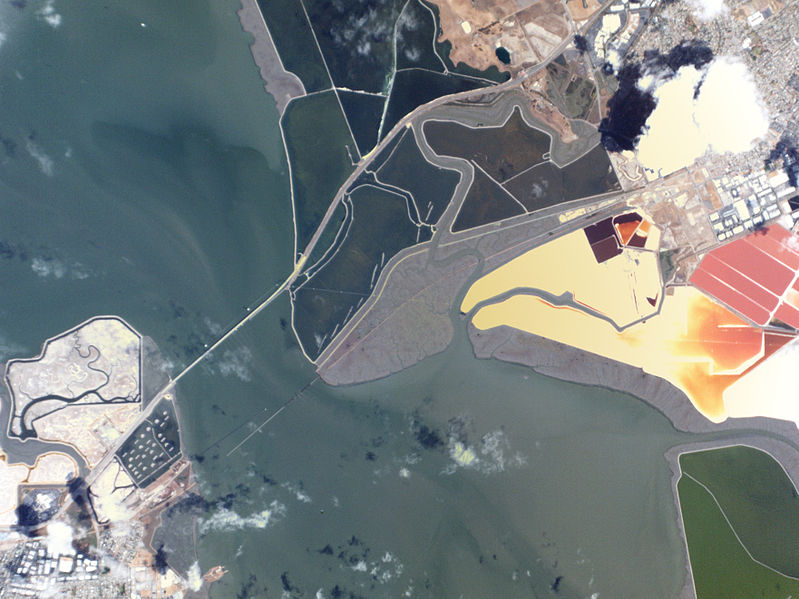When Ariella Jessel and Emily Geagan discovered Temple Beth Abraham in Oakland about three years ago, the synagogue warmly welcomed the Lesbian couple and their young children.
“That was probably one of the factors to joining the synagogue for us — it was diverse, but we weren’t going to be the only same- sex couple or family,” said Geagan. “The sentiment at Temple Beth Abraham is one of inclusiveness.”
The women are part of a diverse, increasingly young and highly-educated Jewish population in the Bay Area — home to the fourth largest concentrations of Jews in the United States, according to a new study released Tuesday.
For the first time, the Jewish Community Federation of San Francisco, the Peninsula, Marin and Sonoma Counties took a comprehensive look at the Jewish-American community in all 10 counties in the region, including Napa, and documented their findings. The study tracked data on the demographics, community needs and other key aspects of the Jewish community.
Some key findings:
— There are 350,000 Jews and 123,000 non-Jews living in 148,000 Jewish households in the Bay Area.
— Young people ages 18-34 make up 37 percent of all adults in Bay Area Jewish households; one-in-ten households includes an LGBT person and one-in-four includes a person of color or mixed racial background and 66 percent of Jews age 35 and under are in an “inter-group marriage” where only one spouse is Jewish.
— Santa Clara County is home to the largest Jewish population — 73,000 — among the 10 counties.
— An estimated 42 percent have a graduate degree in the Bay Area, far more than for Jews elsewhere.
“This is a highly dynamic community and we had reason to think that there may be some changes we need to be aware of,” said Federation CEO Danny Grossman.
The report includes Napa County, but does not break it out specifically. It estimates there are about 47,000 Jewish people in the North Bay, including Napa, Sonoma and Marin counties.
Rabbi Niles Goldstein, who took over leadership at Napa’s Congregation Beth Shalom last year, said the results of the survey square with what he’s seen in the county – the Jewish community is diverse and decentralized and is generally reflective of the broader community.
Much like Napa County generally, “while we have some young families,” he said, “our Jewish community skews a little older” than the Bay Area.
Overall, Jewish people in the Bay Area are less engaged in their culture and heritage than Jews in the rest of the west and far less engaged than Jews in the rest of the U.S., the Jewish Federation study said. An estimated, 26 percent of people in the study said it’s very important to be Jewish, compared with 38 percent in the rest of the west and 48 percent in the U.S.
Goldstein said this finding supports his observation that the Bay Area Jews tends to be less connected to traditional pillars of the community and leery of organized religion. He’s therefore expanding his programming to include non-traditional services and events, such as a seminar this week mixing spirituality with the art of distilling spirits, to attract younger or less traditional people.
Congregation Beth Shalom has about 200 member households and Goldstein estimates that’s only about 10 percent of the total in Napa County, so “our potential for growth is tremendous” with some effective outreach.
Researchers specializing in studying Jewish communities across the U.S. surveyed 3,500 Jews online last year and used the results from that sampling to come up with data on the Bay Area Jewish-American population as a whole. A complete analysis of the report will be shared this spring in an interactive online tool.
The report aims to explore the social landscape of the Jewish community, according to the Jewish Federation, so that Jewish institutions, philanthropists and innovators can better understand their needs.

Dr. Steven Cohen, who co-authored the report, said the sheer size of the Bay Area’s Jewish population is surprising. Also noteworthy is their diversity, he said.
“We have a group that’s economically very diverse as well as diverse in sexual orientation and age,” said Cohen, a sociologist and professor at the Jewish Institute of Religion at Hebrew Union College. “They are now increasingly coming from other ethnic groups which is very interesting and reflects the culture of the Bay Area, which is multicultural.”
Added Grossman, “We’re a welcoming community, including people who are marginally affiliated or consider themselves part Jewish,” he said. “We’re really pleased about that. That wasn’t always the case.”
Jerry Wagner, 62, a devout Jew born and raised in Oakland, has gone to Temple Israel in Alameda for the past 35 years, foregoing moves to other cities or states to stay close to what he calls his “temple family.” It’s where he attends services every Friday, just a short walk from his home. It’s the synagogue where his kids grew up.
“The synagogue for us was like the center of our social world,” he said.
But several people said it’s become increasingly difficult to stay in tune with Jewish culture because many Jewish-Americans are straying away from the traditional practices, such as regularly going to synagogue.
Sara Gaviser Leslie of Menlo Park, said “People don’t want to practice Judaism the same way their parents did.”
Leslie, 45, enrolls her kids in Hebrew school and in Jewish camp every year and said she wants Judaism to be “a source of joy and connection” for her family. But she’s noticed that not everyone appears to be as interested in their Jewish roots And, unlike her Minneapolis hometown, which had its own Jewish country club — the Bay Area lacks concentrated Jewish communities, Leslie said.
Ariella Jessel and Emily Geagan said they felt much more in tune with other Jewish-Americans when they lived in Los Angeles more than a decade ago. Jessel, who grew up in Southern California, taught Hebrew school for many years, from the time she was in junior high through college.
“When we first moved up here, I felt like I lost a part of that. I felt a little isolated,” Jessel said. “In LA you could see the Jews. Here it’s almost covert. It’s not as pronounced.”
Editor’s Note: Register Editor Sean Scully contributed to this report


























